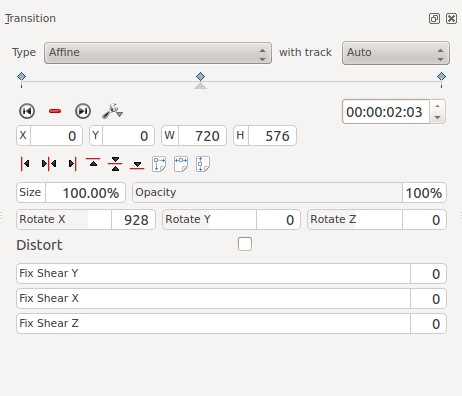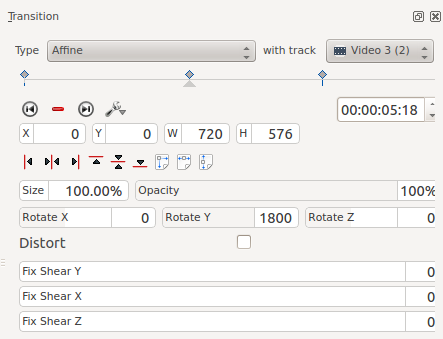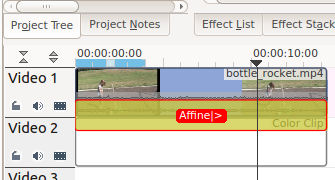Kdenlive/Manual/Transitions/Affine: Difference between revisions
| Line 8: | Line 8: | ||
In many applications this transition can be used instead of a [[Special:MyLanguage/Kdenlive/Manual/Transitions/Composite|Composite]] transition and this provides a workaround to the composite transition "green tinge" bug reported by some. (Mantis #[http://www.kdenlive.org/mantis/view.php?id=2759 2759]) | In many applications this transition can be used instead of a [[Special:MyLanguage/Kdenlive/Manual/Transitions/Composite|Composite]] transition and this provides a workaround to the composite transition "green tinge" bug reported by some. (Mantis #[http://www.kdenlive.org/mantis/view.php?id=2759 2759]) | ||
==== Example 1 ==== | |||
{{#ev:youtube|hylowKurZaw}} | {{#ev:youtube|hylowKurZaw}} | ||
[[File:Kdenlive Affine transition.png]] | [[File:Kdenlive Affine transition.png|frame|left|Affine Transition]] | ||
<br clear=all> | |||
====Disolve using Affine Transition ==== | |||
To add a dissolve change the opacity to zero percent. | To add a dissolve change the opacity to zero percent. | ||
==== Rotation using Affine Transition ==== | |||
To rotate the image add a keyframe and enter values for rotation. The units are 10ths of degrees. (e.g. 900 = 90 degree rotation). | To rotate the image add a keyframe and enter values for rotation. The units are 10ths of degrees. (e.g. 900 = 90 degree rotation). | ||
| Line 20: | Line 23: | ||
Rotate Y and Rotate Z create the illusion of 3D rotation when used dynamically with keyframes - see example below. | Rotate Y and Rotate Z create the illusion of 3D rotation when used dynamically with keyframes - see example below. | ||
==== Example 2 - Rotate Y ==== | |||
{{#ev:youtube|IAWMIL7c9K4}} | |||
This example is created using 3 key frames. The second key frame is shown below with a rotate Y value of 1800 (=180 degrees). The key frame one and keyframe two both have rotate Y values of zero. | This example is created using 3 key frames. The second key frame is shown below with a rotate Y value of 1800 (=180 degrees). The key frame one and keyframe two both have rotate Y values of zero. | ||
[[File:Kdenlive Affine rotate kf2.png]] | [[File:Kdenlive Affine rotate kf2.png|frame|left|Keyframe two]] | ||
[[File:Kdenlive Affine rotate timeline.png | [[File:Kdenlive Affine rotate timeline.png|frame|left|Timeline for this demo clip]] | ||
Timeline for this demo clip | |||
<br clear=all> | |||
The difference between rotate Y and rotate Z is that the apparent rotation in rotate Y appears to be around a horizontal axis. The rotation in rotate Z appears to be around a vertical axis | The difference between rotate Y and rotate Z is that the apparent rotation in rotate Y appears to be around a horizontal axis. The rotation in rotate Z appears to be around a vertical axis | ||
Revision as of 10:19, 22 April 2013
Affine Transition
Generates image rotation in 3D space, skew and distortion.
Provides keyframable animated affine transformations with dissolve functionality.
In many applications this transition can be used instead of a Composite transition and this provides a workaround to the composite transition "green tinge" bug reported by some. (Mantis #2759)
Example 1

Disolve using Affine Transition
To add a dissolve change the opacity to zero percent.
Rotation using Affine Transition
To rotate the image add a keyframe and enter values for rotation. The units are 10ths of degrees. (e.g. 900 = 90 degree rotation).
Rotate X rotates the frame in the plane of the screen.
Rotate Y and Rotate Z create the illusion of 3D rotation when used dynamically with keyframes - see example below.
Example 2 - Rotate Y
This example is created using 3 key frames. The second key frame is shown below with a rotate Y value of 1800 (=180 degrees). The key frame one and keyframe two both have rotate Y values of zero.


The difference between rotate Y and rotate Z is that the apparent rotation in rotate Y appears to be around a horizontal axis. The rotation in rotate Z appears to be around a vertical axis
